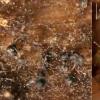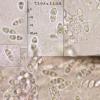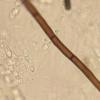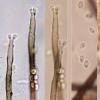
30-12-2012 09:27
Patrice TANCHAUDBonjour,récolte réalisée dans un lieu incendié

29-12-2012 19:03
 Alessio Pierotti
Alessio Pierotti
Qualche amico ha il volume:Fungus flora of Venezue

29-12-2012 15:41
 Alessio Pierotti
Alessio Pierotti
Qualcuno ha questo articolo ?HAWKSWORTH, D. L., AT

29-12-2012 12:07
Is it possible that nobody has a copy of this arti

11-12-2012 21:00
 Gilles Corriol
Gilles Corriol
Je tente ma chance une nouvelle fois, ce coup ci a

28-12-2012 13:48
Hi againThese gregarious, small (up to 0.6 mm), sh
Chaetosphaeria on Quercus
Enrique Rubio,
26-11-2012 17:39
We have collected these small (up to 0.15 mm), gregarious, black, superficial, globose and hairy perithecia on Quercus wood.
The prithecia grew among conidiomata of a dematiaceous mould and their ascospores breaking into equal-sized part-spores of 7-9 x 3-4 microns.
Could this fungus be Chaetosphaeria vermicularioides or Ch. preussii? Can these conidiomata belong to the anamorphic state?
Many thanks for your help
Alain GARDIENNET,
27-11-2012 08:54
Re : Chaetosphaeria on Quercus
Hi Enrique,
You are near to the solution.
It seems to be a Chloridium anamorph.
Can you give exactly the size of ascospores or ascospores part if it's really fragmented (is it ?) and conidiospores. Your fungus is probably in the group : preussi/vermicularioides/myriocarpa/lentomita/barbicincta.
Have you Reblova's paper ?
Amitiés,
Alain
You are near to the solution.
It seems to be a Chloridium anamorph.
Can you give exactly the size of ascospores or ascospores part if it's really fragmented (is it ?) and conidiospores. Your fungus is probably in the group : preussi/vermicularioides/myriocarpa/lentomita/barbicincta.
Have you Reblova's paper ?
Amitiés,
Alain
Jacques Fournier,
27-11-2012 09:25

Re : Chaetosphaeria on Quercus
Hola Enrique,
d'accord avec toi et Alain. Je pense que C. vermicularioides est l'espèce qui correspond le mieux à ta récolte à cause de la conidiogenèse multiple que l'on voit bien sur ta photo de la collerette terminale. La largeur des spores correspond aussi mieux qu'à C. preussii.
Malheureusement je ne connais pas bien ces espèces et un avis plus compétent serait le bienvenu.
Amitiés,
Jacques
d'accord avec toi et Alain. Je pense que C. vermicularioides est l'espèce qui correspond le mieux à ta récolte à cause de la conidiogenèse multiple que l'on voit bien sur ta photo de la collerette terminale. La largeur des spores correspond aussi mieux qu'à C. preussii.
Malheureusement je ne connais pas bien ces espèces et un avis plus compétent serait le bienvenu.
Amitiés,
Jacques
Enrique Rubio,
27-11-2012 19:51
Re : Chaetosphaeria on Quercus
Hi Alain and Jacques
The ascospores are fully disarticulate at maturity and the part-spores reaching 3.5-4.7 x 2.7-3.7 microns.
The conidia are 4.6-5.4 x 2.7-2.8 microns.
No. I have not Reblova´s paper
Many thanks to both
The ascospores are fully disarticulate at maturity and the part-spores reaching 3.5-4.7 x 2.7-3.7 microns.
The conidia are 4.6-5.4 x 2.7-2.8 microns.
No. I have not Reblova´s paper
Many thanks to both
Alain GARDIENNET,
27-11-2012 20:08
Re : Chaetosphaeria on Quercus
Ce papier est dans le SIM 45 mais je te l'envoie dans ta boîte.
Alain
Alain



